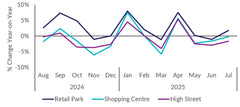
Navigating the Omnichannel Shopping Experience: Strategies for Success in 2025
Table of Contents
- Key Highlights
- Introduction
- Understanding Today’s Omnichannel Reality
- Unify Your Data in a Single Source of Truth
- Manage Campaigns from a Unified Hub for Real-Time Omnichannel Orchestration
- Automate Lifecycle Management Across Marketing and Customer Support
- Use AI for Cross-Channel Personalization and Efficiencies
- Klaviyo: The Only CRM Built for B2C
Key Highlights
- Omnichannel Engagement: 77% of omnichannel shoppers utilize 3-4 channels for product research and purchasing, indicating a critical shift in shopping behavior.
- Data Unification: Brands must consolidate their data into a single source of truth to enhance customer personalization and campaign effectiveness.
- AI Integration: Leveraging AI tools for cross-channel personalization and customer engagement is becoming essential for modern retail strategies.
Introduction
The retail landscape is undergoing a monumental transformation, driven largely by the omnichannel shopping experience. Shoppers today are not just engaging with brands through a single touchpoint; they are utilizing multiple channels—such as social media, mobile apps, and in-store visits—to navigate their purchasing journeys. According to Klaviyo’s 2025 omnichannel shopping survey, a staggering 77% of consumers now employ three to four different channels to research and make purchases. This evolution in shopping behavior necessitates that brands rethink their marketing strategies and adopt a more integrated approach.
As consumers increasingly demand seamless interactions across various platforms, businesses must unify their data, manage campaigns effectively, and harness the power of automation and artificial intelligence (AI). This article delves into the essential strategies brands need to implement in order to thrive in today's omnichannel environment, focusing on data unification, campaign management, lifecycle automation, and AI utilization.
Understanding Today’s Omnichannel Reality
The omnichannel shopping experience is defined by the integration of various platforms and channels through which consumers interact with brands. This multifaceted approach allows for a more personalized shopping experience and caters to the diverse preferences of consumers. The Klaviyo survey reveals significant variations in channel preferences based on product categories. For instance, beauty shoppers tend to browse primarily on social media and shop in-store, while electronics customers prefer company websites for both browsing and purchasing.
Channel Preferences by Category
The following table illustrates the top channels for browsing and purchasing across various categories:
| Category | Top Channels for Browsing | Top Channels for Purchasing |
|---|---|---|
| Beauty | 1. Social media 2. Branded mobile app 3. In-store |
1. In-store 2. Company website 3. Branded mobile app |
| Electronics | 1. Company website 2. In-store 3. Marketplaces |
1. In-store 2. Company website 3. Marketplaces |
| Fashion/Apparel | 1. In-store 2. Company website 3. Social media |
1. In-store 2. Company website 3. Social media |
| Home Goods | 1. In-store 2. Company website 3. Marketplaces |
1. In-store 2. Company website 3. Marketplaces |
| Restaurants | 1. In-store 2. Company website 3. Social media |
1. In-store 2. Company website 3. Social media |
| Travel and Hotels | 1. Company website 2. Social media 3. Branded mobile app |
1. Company website 2. In-store 3. Branded mobile app |
| Spas/Fitness Studios | 1. Company website 2. In-store 3. Social media |
1. Company website 2. In-store 3. Social media |
This data underscores the necessity for brands to adapt their strategies to cater to the channels that resonate most with their target audiences.
Unify Your Data in a Single Source of Truth
In the age of omnichannel retailing, data silos can severely hinder a brand's ability to engage effectively with customers. According to Klaviyo’s state of B2C marketing report, the average B2C brand utilizes between six to fifteen different tools. When these tools operate in isolation, brands face challenges such as inconsistent messaging, poor customer segmentation, and incomplete attribution of marketing efforts.
Benefits of a Unified Data System
A consolidated approach to data management allows brands to create a single customer view—an invaluable asset that enables:
- Enhanced Personalization: Brands can tailor experiences based on a complete understanding of customer interactions across channels.
- Consistent Messaging: Unified data ensures that customers receive coherent communications regardless of the platform they use.
- Effective Segmentation: Brands can segment their audience more accurately, leading to targeted campaigns that resonate with specific demographics.
For instance, McConnell’s Fine Ice Creams successfully integrated its data from various systems to provide a cohesive experience for both online and in-store customers. This unification allowed them to send tailored offers and promotions based on customer behavior, leading to increased sales and customer satisfaction.
Manage Campaigns from a Unified Hub for Real-Time Omnichannel Orchestration
Once brands establish a centralized data system, they can implement real-time campaign management that spans multiple channels. This orchestration involves defining the campaign’s purpose, segmenting the audience, and coordinating messaging across all platforms.
Defining Campaign Types and Segments
Brands can initiate campaigns focused on various objectives, such as:
- Brand Awareness: Using social proof and engaging content to elevate brand visibility.
- Product Promotions: Highlighting new products or seasonal offers to drive sales.
- Customer Offers: Providing exclusive discounts or flash sales to incentivize purchases.
By understanding their audience and tailoring campaigns accordingly, brands can significantly enhance engagement rates and overall effectiveness.
Coordinating Launch Across Channels
Successful omnichannel campaigns require meticulous planning to ensure that messages are synchronized across all platforms. For example, when launching a new product, brands might:
- Send an announcement email to engaged subscribers.
- Utilize social media ads to retarget interested customers.
- Trigger SMS alerts to segments likely to convert based on past purchasing behavior.
Happy Way, a health supplement brand, exemplified this strategy during the 2023 Black Friday Cyber Monday season by segmenting their audience based on dietary preferences and channel engagement, resulting in over $350,000 in revenue attributed to their Klaviyo campaigns.
Automate Lifecycle Management Across Marketing and Customer Support
Beyond individual campaigns, brands must also automate customer lifecycle management, ensuring a seamless experience from initial engagement to post-purchase support.
Channel-Specific Welcome Flows
Brands should create tailored welcome flows for new subscribers to establish a positive first impression. For example, a welcome series can introduce products, gather subscriber preferences, and encourage conversions while being mindful to avoid redundancy across channels.
Educational Post-Purchase Flows
After a customer makes a purchase, brands can utilize various channels to reinforce value and encourage repeat business. This could involve sending detailed guides via email, quick tips via SMS, or even follow-ups through WhatsApp to check on customer satisfaction.
VIP Loyalty Outreach
For frequent shoppers and high-spenders, personalized outreach is crucial. Brands can notify VIP customers of new loyalty tiers, early access to sales, or exclusive offers through their preferred communication channels, thus enhancing their engagement and loyalty.
Use AI for Cross-Channel Personalization and Efficiencies
As the reliance on technology grows, brands are increasingly turning to AI to enhance their omnichannel strategies. According to Klaviyo’s forecasts, a significant percentage of consumers prefer AI-driven personalization over traditional interactions.
AI-Powered Product Recommendations
AI can analyze customer purchasing behavior and preferences to create personalized product recommendations, which can be seamlessly integrated into marketing campaigns. This not only improves customer satisfaction but also boosts conversion rates.
Intelligent Channel Orchestration
By leveraging AI, brands can evaluate customer engagement across different channels and optimize message delivery accordingly. This ensures that customers receive communications via the channels they are most likely to engage with.
Predictive Analytics
AI can also provide predictive insights into customer behavior, such as likelihood to churn or expected purchase dates, allowing brands to tailor their messaging and offers to preemptively address customer needs.
Klaviyo: The Only CRM Built for B2C
Klaviyo stands out as a dedicated CRM designed specifically for B2C brands, providing the tools needed for effective omnichannel retailing. By integrating various communication channels—like email, SMS, and push notifications—Klaviyo enables brands to create cohesive and engaging customer experiences.
Omnichannel Campaign Builder
The platform's omnichannel campaign builder allows marketers to design and manage multi-segment campaigns from a single interface. Key features include:
- Full Visibility: Brands can track which messages are sent to which audiences, ensuring clarity and consistency across campaigns.
- Channel Affinity: The system automatically optimizes message delivery based on customer preferences and engagement patterns.
- Performance Tracking: Marketers can monitor campaign effectiveness through detailed analytics, enabling continual optimization and improvement.
By leveraging Klaviyo, brands can break free from fragmented marketing efforts and create data-driven strategies that resonate with their audiences.
FAQ
What is omnichannel shopping?
Omnichannel shopping refers to a retail approach that integrates various shopping channels—like online, in-store, and mobile—to provide a seamless customer experience.
Why is data unification important in omnichannel marketing?
Data unification eliminates silos, allowing brands to create a comprehensive view of customer interactions. This enhances personalization, consistency in messaging, and effective audience segmentation.
How can AI improve omnichannel strategies?
AI can enhance cross-channel personalization, optimize message delivery, and provide predictive insights into customer behavior, enabling brands to tailor their marketing efforts effectively.
What are some examples of successful omnichannel strategies?
Brands like McConnell’s Fine Ice Creams and Happy Way have successfully implemented unified data systems and targeted omnichannel campaigns, leading to significant increases in revenue and customer engagement.
How can I start implementing an omnichannel strategy for my business?
Begin by assessing your current data systems and identifying areas for integration. Focus on unifying your customer data, planning targeted campaigns, and exploring AI tools that can enhance your marketing efforts.
In conclusion, as the landscape of retail shifts toward an increasingly connected consumer journey, brands must adapt their strategies to leverage the full potential of omnichannel marketing. By unifying data, automating lifecycle management, and utilizing AI-driven insights, businesses can engage customers in meaningful ways and drive sustained growth.
Potencia tu comercio electrónico con nuestros informes y actualizaciones semanales!
Mantente alineado con lo que está sucediendo en el mundo del comercio
Dirección de correo electrónico
Seleccionado para Ti

07 August 2025 / Blog
Declining Retail Footfall: Insights into July 2025 Trends and Implications for the UK Retail Sector
Leer más
07 August 2025 / Blog
Fragrance Industry Dynamics: Analyzing Growth Trends and Market Shifts in 2025
Leer más
07 August 2025 / Blog


